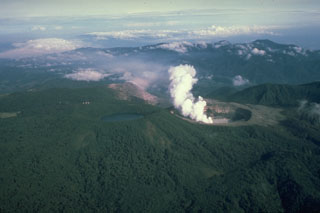Report on Poas (Costa Rica) — 1 January-7 January 2025
Smithsonian Institution / US Geological Survey
Weekly Volcanic Activity Report, 1 January-7 January 2025
Managing Editor: Sally Sennert.
Please cite this report as:
Global Volcanism Program, 2025. Report on Poas (Costa Rica) (Sennert, S, ed.). Weekly Volcanic Activity Report, 1 January-7 January 2025. Smithsonian Institution and US Geological Survey.
Poas
Costa Rica
10.2°N, 84.233°W; summit elev. 2697 m
All times are local (unless otherwise noted)
The Observatorio Vulcanologico y Sismologico de Costa Rica-Universidad Nacional (OVSICORI-UNA) reported that an eruptive event from the S part of the lake at Poás was recorded at 0610 on 5 January. The event ejected dark material several meters above the surface of the lake. The event was preceded by a period of slow intensification of several monitoring parameters first observed during November and December 2024, including increased seismicity, an anomalous trend in the ratio of sulfur dioxide and carbon dioxide that accelerated on 5 January, increased gas emissions, and an increase in lake temperatures. Unrest continued during 6-7 January; increased tremor was associated with visible bubbling in the lake during 1400-1700 on 6 January.
Geological Summary. The broad vegetated edifice of Poás, one of the most active volcanoes of Costa Rica, contains three craters along a N-S line. The frequently visited multi-hued summit crater lakes of the basaltic-to-dacitic volcano are easily accessible by vehicle from the nearby capital city of San José. A N-S-trending fissure cutting the complex stratovolcano extends to the lower N flank, where it has produced the Congo stratovolcano and several lake-filled maars. The southernmost of the two summit crater lakes, Botos, last erupted about 7,500 years ago. The more prominent geothermally heated northern lake, Laguna Caliente, is one of the world's most acidic natural lakes, with a pH of near zero. It has been the site of frequent phreatic and phreatomagmatic eruptions since an eruption was reported in 1828. Eruptions often include geyser-like ejections of crater-lake water.
Source: Observatorio Vulcanologico y Sismologico de Costa Rica-Universidad Nacional (OVSICORI-UNA)

